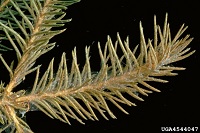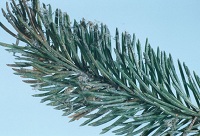Oligonychus ununguis
Hosts
Colorado and white spruce
Appearance and Life Cycle


The spruce spider mite completes up to 8 generations a year. Adult mites are microscopic (0.5 millimetres (mm)) and dark green to dark brown in color. Feeding begins in mid-May and continues throughout the growing season. Over-wintering eggs are produced from September until a severe frost.
Damage
The spruce spider mite injures the needles by inserting its slender mouthparts and sucking out the sap. The puncture causes a stippled, bleached discoloration. In severe infestations the needles become dingy yellow or brownish and often needles dry and drop off. Damage is usually first noticed on the lower inside branches but spreads upward and outward as the infestation progresses. The mites spin fine silken webbing throughout the twigs and needles. The webbing is most noticeable on the underside of the branches where dust particles, dead needles and dead mites adhere. In spruce plantings, infestations can persist for years resulting in reduced tree vigor and eventually death. Recently planted trees, nursery seedlings, or trees under stress are especially susceptible to serious injury. To check for mite infestations, vigorously shake a branch over a piece of white paper, then rub your hand across the paper or press the paper in half. If red smears appear, mites are probably present. Trees should be checked regularly since mite populations can increase rapidly.
Control
Heavy rain accompanied by high winds and extreme temperatures are means of natural control. Some control can be achieved by washing infested trees with a strong jet of water. For shelterbelts or large trees, the following insecticides can be used: diazinon, dicofol, or malathion. Insecticides must be applied at high pressure so the spray penetrates the inner branches and webbing. A second application may be required two weeks after the initial spray.